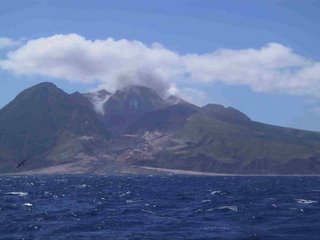Montserrat

The 40 miles across from Guadeloupe to Montserrat was the best close reach so far with a fairly steady speed of 8 knots. Seas were almost non existent (Kelli you would of liked this) unfortunately with no opportunity for bow riding. We went up the east side of Montserrat to avoid ash fall from the volcano and adhered to the two mile exclusion zone. The view of the volcano held our attention for most of the trip. As a matter of fact while I was getting the binoculars for a closer look, we had an opportunity to practice our man over board drill as my pillow went overboard.
Every time we leave an island Jenessa is quick to put out the fishing line and she has high hopes of providing dinner. This time she was actually at the line when the bungee stretched out. As she reeled it in, we discovered a dolphin fish (not the mammal) with an estimated length of 3 feet. Ron took over for her as it got close to the boat and tried to bring it up over the dinghy and unfortunately it shook loose.
We had the most amazing tour of Montserrat with taxi driver/tour guide, Joe Phillips. He is the driver recommended in our cruising guide and I am very happy we were able to go with
 him. Montserrat is an active volcano that started erupting in 1995 and continues still. It actually has the record of being the largest recorded dome to collapse. Joe was able to explain what it was like to live in a community that had to be evacuated with all of the residence being temporarily relocated and then permanently relocated. He also had many before and after photos for us to see the startling changes. It was very profound to walk through the town of Plymouth. People were forced to walk away from their business, schools, churches and homes leaving most things behind. Ash in some locations in the town was piled 10 feet high. Houses with asphalt shingles had intact roofs but buildings with metal roofs were eaten away by the sulphuric acid.
him. Montserrat is an active volcano that started erupting in 1995 and continues still. It actually has the record of being the largest recorded dome to collapse. Joe was able to explain what it was like to live in a community that had to be evacuated with all of the residence being temporarily relocated and then permanently relocated. He also had many before and after photos for us to see the startling changes. It was very profound to walk through the town of Plymouth. People were forced to walk away from their business, schools, churches and homes leaving most things behind. Ash in some locations in the town was piled 10 feet high. Houses with asphalt shingles had intact roofs but buildings with metal roofs were eaten away by the sulphuric acid. 
Montserrat seems to be rebuilding with their population back up to 5000 from the low of 3000 but still along way to go to the original 11000. Tourism, agriculture and the exportation of building sand are three side effects from a volcano and Montserrat is benefiting from these. Now this was a great way to learn about volcanoes.
Next stop Nevis.

0 Comments:
Post a Comment
<< Home